HTC Vive Review
HTC Vive Review
After the price hike, is the Vive still worth it?
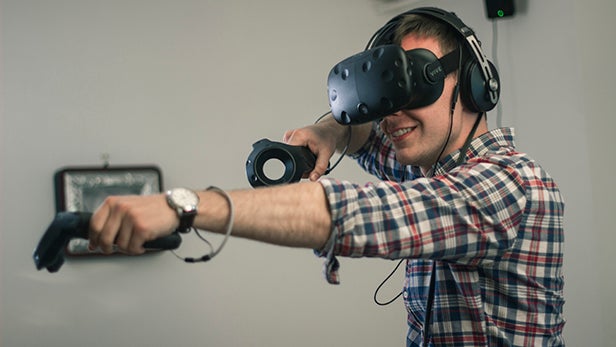
Verdict
Pros
- Incredible, immersive free-moving VR
- Intuitive controllers with good battery life
- Solid selection of games already available
- Nothing else quite like it
Cons
- Pain to set up
- Software is buggy
- Expensive and needs lots of space
Key Specifications
- Review Price: £599.99
- 1,200 x 1,080 resolution AMOLED screen for each eye
- Requires a powerful gaming PC
- HTC Vive controllers for each hand
- Two tracking sensors
- Bluetooth for phone connection
- Front-facing camera
What is the HTC Vive?
If you’ve tried Google Cardboard, Gear VR or the Oculus Rift and think you know what virtual reality has to offer, then prepare for a rude awakening. The HTC Vive delivers the most immersive virtual reality experiences available right now. It’s incredible, and tops a promising 2016 for HTC after the excellent HTC 10.
Trying to describe it in words is a tall order – there are none that can do it justice. It’s like trying to draw a symphony or sculpt a ballet – the essence can be evoked, but it needs to be experienced to be truly understood.
This means that this review will be different to TrustedReviews’ usual ones. I’ll still make sure that all the positives and negatives are covered, but before you worry about any of that, you need to know that the HTC Vive is immense, wonderful and utterly fantastic.
Related: VIVE Pro hands-on
Related: Amazon Prime Day 2018
Getting started with the HTC Vive
Development may have started later than it did for its major competitor, the Oculus Rift, but in many ways the Vive is the more complete product.
You can walk around and interact with virtual worlds by using specialised controllers that come bundled with the Vive. This is its biggest strength. It’s also its biggest weakness.
The sheer amount of space you need to dedicate to make the most out of the HTC Vive will make it a challenge for many to have it in their home. It’s also the most expensive VR headset out there.
Still, if you’ve got the cash, and enough spare room, then the HTC Vive provides experiences you just can’t get anywhere else.
Related: PlayStation VR review

Before you start doing anything, it’s worth making sure that your gaming PC is powerful enough to run the HTC Vive. Its minimum system requirements are a touch lighter than the Oculus Rift’s, but you’ll still need a good graphics card and a recent processor.
I tested it with a Nvidia Geforce GTX 970 and it worked fine, but if you want to max out the settings on some games you’ll need something heftier. The two screens within the headset – one for each eye – have a 1080 x 1200 resolution, and with the very high frame rate required you need about three times the power you would for gaming at 60fps on a Full HD monitor. I also tested the Vive with a Nvidia Geforce GTX 980Ti in the Titan Virtual Force PC and I found the experience a little slicker.
Related: Best Gaming PC: Build your own VR gaming PC
The sheer size and weight of the HTC Vive’s packaging is a little alarming. Thankfully, plenty of what’s inside is padding, but there are a lot of parts in there too.
Aside from the headset there are two sensor cubes, two chunky controllers, a link box and enough plugs and Micro USB cables to start a small airport electronics shop.
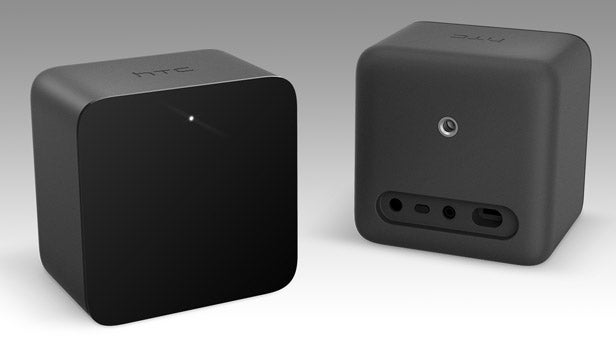
The sensors are important. They’re what tell the Vive where you’re standing, but also the exact location of the controllers – a fine grid appears when you get a little too close to bumping into something. They come with mounting brackets, so they can be screwed into the wall, and need to be placed high (around 2m) and facing downwards a little to cover as large an area as possible.
Related: HTC Vive vs Oculus Rift
HTC recommends a 2 x 1.5-metre space, but I’d suggest at least a 2 x 2-metre one. Some games warn you if your setup doesn’t allow for a 3 x 3m area. I wasn’t joking, owning a Vive is a bit like having a pool table – you need a big space for it.
You can use the Vive as a sit-down or stand-still experience, but I really don’t see the point of that. Both the games and the controllers are designed for expansive movements and shackling yourself to a chair or a single spot is far too restraining.
No, it’s far better to just accept that you need to dedicate a space to it.

This does make the Vive hard to setup. There are downloads and registrations and then further downloads until you think you’re done. And then everything needs a firmware update so you need to get the USB cables out and connected to your PC. All of this is interspersed with helpful tips such as “remove pets” so you don’t trip over them. HTC clearly hasn’t met my cat.
A helpful step-by-step guide does its best to make the setup idiot-proof, but it still took me over an hour, 17 post-watershed swear words and a couple of PC restarts to get everything to work.
It’s worth noting the Vive takes up at least three plug sockets, too – one for each sensor and one for the link box that connects the headset to the PC. There are also two plugs and Micro USB cables for recharging the controllers, but I found it easier to just plug them into spare USB ports on the PC.
So setting up the Vive is a faff, but once it’s done you don’t need to tinker. I’ve had the Vive set up for over a week and it’s worked well every time I turn it on. Oh, well, there are crashes that need a restart to get it working again, and at times the sensors refuse to recognise the headset or controllers, but I never had a showstopper. It’s nowhere near as robust as the Oculus Rift, but the reward makes it easier to forgive the occasional gremlin.
Related: Oculus Touch review

The headset itself is a good-looking thing. The dimpled plastic makes the Vive seem suitably futuristic and the straps are easy to adjust for a good fit. Whichever way you adjust it, though, it feels a little wobbly, as if it might fall off your head. It won’t, of course, and the more you use it the more you trust it will stay put.
More of an issue is the Vive’s weight. It’s 555g without the cables, and a fair bit more with them, and you need to add another couple of hundred grams if you want to use over-ear headphones. The bundled in-ear headphones are rubbish and keep popping out, so you’ll want to use your own.
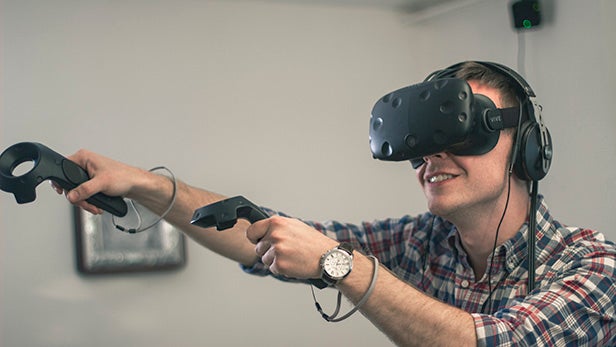
Initially, I found myself not bothered by the weight while playing, but a cricked neck a few hours later made me take note. I hope HTC can reduce the weight in the future, since I can use the Oculus Rift without discomfort for much longer than the Vive.
Related: Best RPG games
Controllers made for VR
The HTC Vive’s dual controllers are brilliant. Made of solid plastic, they’re ideal tools for interacting with a virtual environment. There are plenty of buttons and controls, but I never felt lost because everything is where it should be and the controllers are visible, floating through the air, when the visor is on.
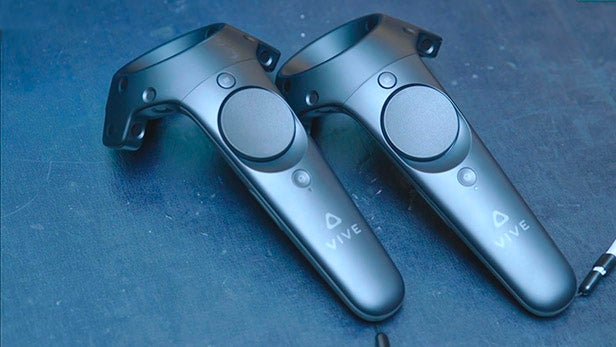
The triggers are perfectly placed and the grip feels like you’re holding a gun. It makes them perfect for shooting games. I’ve spent hours on end firing a pistol in the brilliant multiplayer game Hover Junkers. It feels about as close to shooting a real gun as you can without the acrid smell of gunpowder filling your nostrils. The grip also serves well as a hilt when using a sword in a game.
Clench your fist a little more tightly and you can activate a button on the grip. It feels like trying to grasp something in real life and works well with games that require you to pick up items.
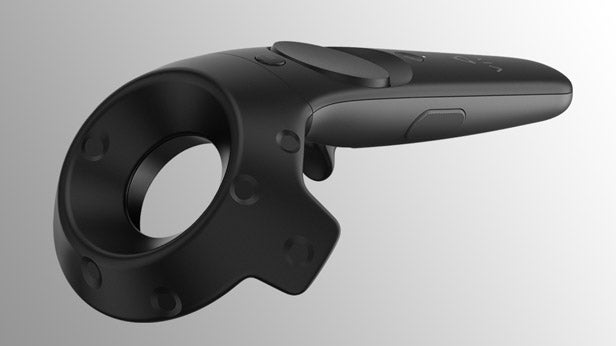
The touchpads that I didn’t get on with on the Steam Controller are a revelation on the HTC Vive. They’re useful for scrolling, but the pad is also a button. Some games map different actions depending on where you press too, a bit like a D-pad.
If there’s one (minor) complaint, it’s that the “select” button is a little too high to get to easily. That’s eminently forgivable, though. The HTC Vive’s controllers are spot on for virtual reality, proving that Oculus’ dedicated controllers can’t come soon enough. The Xbox One controller is a poor substitute for VR.
Related: Best VR Games
Living with the HTC Vive
While the controllers are great, Steam VR and Vive Home are less of a triumph. HTC’s tried to emulate the Oculus Home environment, but it’s not as slick or robust. For starters, you can begin games from two environments: Steam or Vive Home. It’s confusing and I ended up switching between the two with neither quite fitting the brief. Some settings can be tweaked from one and some from the other. It’s all a bit messy.
I also found Steam VR to be temperamental – it’s still in Beta and I can see why. I’ve had to restart my PC more than a dozen times due to games not exiting properly or from incorrect calibrations. Thankfully, the Vive worked every time following a quick reboot.
Yet, annoying as these issues are, I find them easy to forgive once you begin exploring the Vive’s VR worlds.
There’s plenty to get stuck into, but the games the Vive come bundled with aren’t a patch on the Oculus Rift’s Lucky’s Tail or EVE: Valkyrie. They are fun, though. Job Simulator is cute, funny and a good entry to the world of VR, while Fantastic Contraption is a solid puzzler that reminds me of Besige and is brought to life by the controllers. Tilt Brush isn’t a game at all – made by Google, it lets you draw in 3D and people with a more artistic leaning than me may find hours of fun with it.
Happily there are a bunch of titles that you can buy on Steam that are excellent and I’ve already become obsessed with Hover Junkers.
Set in a post-apocalyptic world, you’re in charge of a hovering ship. Your aim in the arenas is to pick up junk and store it or, more importantly, use it to form walls around your ship. This junk shields you from other junkers and gives you something to cower behind while you reload your weapons. As of writing there are only two weapons – a shotgun and pistol – but they feel solid and, if your aim is true, can be devastating.
Related: Best Racing Games
Ducking and dodging to get your shot in is brilliant – if this is what future multiplayer shooters will feel like then I can’t wait. Playing it is a proper workout. I squat behind cover and jump out to fire or run to the other end of the ship when my junk is shot off (which sounds more painful than it is) and I’m in the open. It may not be pretty, but there’s nothing else like it and it might lead to a new breed of super-fit gamers. We can dream.
Another game that I fell in love with is Vanishing Realms. This is a traditional dungeon RPG lifted to new heights by the HTC Vive and its controllers. I found myself literally crawling across the floor to avoid traps and pick up a little gold for a better sword. It’s utterly immersive to the point where I put a virtual-reality apple to my mouth to recover health and I ended up opening my mouth in real life. I felt like a total idiot, but I’ve seen others do exactly the same thing.
There are occasions when I wish the HTC Vive was wireless, though. Those long, trailing cables do get in the way when you’re walking around a virtual world, but I didn’t find this as annoying as I thought I would. You can feel them and just step over or kick them out of the way.
The Vive is packed with features, but some don’t work very well. It has Bluetooth so you can pair it with your phone and take calls with the visor on, but I couldn’t get this to work with the iPhone 6S or Huawei Mate 8.
The clever front-facing camera, on the other hand, lets a small screen appear near your right controller to give you a view of the outside world. Unfortunately, it’s not well realised – it’s either always on or always off, with no in-between. Room View can be toggled in-game by pressing the menu button twice, but this gives you a weird, ethereal view of your space. I imagine it’s a bit like Daredevil’s “vision”.
Not a hint of sickness
The virtual-reality landscape is already vibrant and rich, and the games are designed in a way that reduces virtual-reality sickness. I didn’t experience any nausea while playing on the Vive, which is something I can’t say about the Oculus Rift.
It’s not the technology that’s better; it’s that the games are smarter. For example, Hover Junkers doesn’t let you rotate your ship. You move forwards, backwards, left and right, but there’s no turning, and that makes all the difference.
Vanishing Realms lets you move around by “teleporting” you to locations that you point at with your controller. Most games and demos seem to use this mechanic. It’s clever and, while not quite as immersive as walking or running through areas, I’ll take it if it means not feeling sick.
Should I buy the HTC Vive?
If you have the space to dedicate to it and a PC good enough to power it, the Vive is a must-have gadget for every tech head. Those are big ifs, though. I can just about get it to work well in my living room, but guess what? That’s not where I keep my gaming PC.
The cost of the Vive and a compatible PC for your living room will be prohibitive for most, as will dedicating a whole room to it. Still, if you can afford it, nothing else compares.
The HTC Vive’s far more immersive than the Oculus Rift – so much so that you forgive the pixelated screen and irritating software foibles. But if you plan to immerse yourself in a virtual world while sitting down, the Rift makes a lot more sense. It’s not as impressive, but it still offers a fantastic experience, if you can avoid the games that might make you reach for a bucket.
Verdict
If you can afford it and have the room for it, the HTC Vive offers, quite simply, the best virtual-reality experience you can get.


